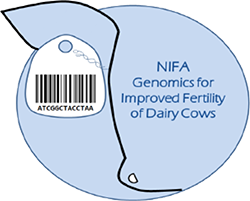GENOMIC SELECTION FOR IMPROVED FERTILITY OF DAIRY COWS WITH EMPHASIS ON CYCLICITY AND PREGNANCY
Following the release of the cattle genome sequence in 2009, the exploration of cattle genomics has extended dramatically. Current molecular technologies provide the opportunity for exploring DNA sequences in search of genomic markers, mainly in the form of single nucleotide polymorphisms (SNPs). These SNPs are the most common type of genetic variation and represent a change in a single DNA building block (nucleotide). As these substitutions are within or in close proximity to genes they can be used as markers related with particular phenotypes of economic interest.
With these advances, traditional progeny testing programs based on the sire’s relatives’ performance are now complemented with this new information. Genomic evaluations increase the accuracy of traditional genetic proofs and reduce the time interval between generations accelerating the genetic gain. The use of genomic information is crucial when the number of available relatives is reduced, which is the case in females and young bulls. Today, genomic evaluations have become official for dairy breeds, and each periodic release of proof information continues to validate genomic technology, with many AI studs relying primarily on genomic selection for development of their young sire programs.
Until recent years, selection of dairy cattle was focused primarily on production and conformation traits. At the present, significant efforts are directed to extend selection programs to other areas including health traits and fertility. In contrast with production traits, health and fertility characters present additional challenges because they are more difficult and expensive to measure, have moderate to low heritability, and may be genetically antagonistic to production traits. Consequently, phenotypic characterization for non-production traits and their respective associations with DNA markers are limited, which poses constraints to future advances genomic selection.
Aware of these limitations and considering the critical role that fertility plays in dairy production, the National Institute of Food and Agriculture (NIFA), through its competitive research funding program in food security has identified translational genomics as an area of investigation to improve fertility of animals. A team of scientists from different US institutions was recently awarded a 5 year grant of US $2.98 million to study genomic markers for selection of reproduction in dairy cattle. The emphasis of this integrated project that includes research, extension, and education components is to characterize in detail phenotypes based on uterine health, resumption of ovulation postpartum, conception and maintenance of pregnancy, and identify DNA markers linked to those phenotypic traits. This is an aggressive effort to collect precise fertility phenotypes in a population that includes cows managed under different breeding protocols and environments, and various types of facilities in five States.
During the whole process the research group will keep close communication with an advisory panel including dairy farmers, USDA investigators, dairy consultants, and AI studs. Resulting SNPs significantly associated with reproductive efficiency will provide a wider understanding of the genetic structure of fertility traits, generating new resources that can be easily incorporated to existing selection programs and quickly implemented at the farm level. This novel information will assist AI studs and dairy producers to make rational and cost-effective decisions for genetic selection to reduce the risk of uterine diseases and to improve fertility.
The team is led by Dr. Pablo Pinedo at Colorado State University, and Dr. José E. P. Santos with the Department of Animal Sciences at the University of Florida. Co-Principal Investigators include William W. Thatcher, Ricardo C. Chebel, and Klibs N. Galvão (University of Florida); Rodrigo C. Bicalho and Robert O. Gilbert (Cornell University); Gustavo M. Schuenemann (The Ohio State University); Guilherme J. M. Rosa (University of Wisconsin); Sandra Rodriguez-Zas (University of Illinois); Christopher Seabury (Texas A&M University); and John Fetrow (University of Minnesota). Areas of expertise in dairy cattle include reproduction and health, genetics, bioinformatics, nutrition, economics, Extension, and education.
